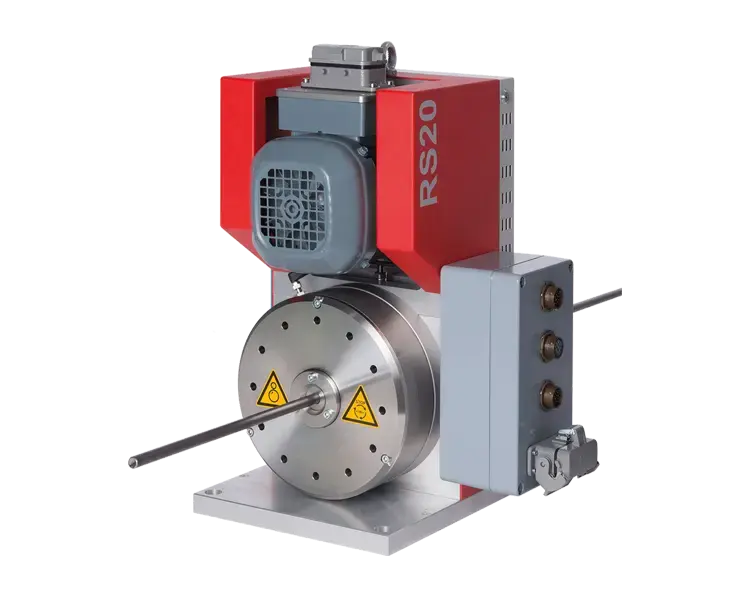
Rotating systems
For identification of longitudinal defects

- Reliable quality assurance for your semi-finished products For wire, bars, seamless tubes
-
Rotating systems in 4 sizes
Diameters from 1.9 to 140 mm to suit any production line -
High-speed eddy current testing
Material throughput speeds of up to 2880 mm/s can be achieved in wire drawing or recoiling systems
Reliable quality assurance for your semi-finished products
- For offline, inline and continuous testing
-
Available in four sizes:
- RS20: 2–20 mm (1/16–3/4 in)
- RS35HS: 3–35 mm (1/8–1¼ in)
- RS65: 5–65 mm (3/16–2½ in)
- RS140: 10–140 mm (3/8–5 1/2") - Electronic lift-off compensation system for optimum signal-to-defect correlation
- Extremely robust design








INTERESTED?
Find out more…
Eddy current testing system with a clever sensor design
Reliable quality assurance for your semi-finished products with diameters from 2 to 20 mm in terms of longitudinal defect detection
Minimum conversion times when changing to a different diameter through replacement of the entire sensor disk
High durability since the sensor has no moving parts
Ideal for installation in production lines (drawing lines) due to compact design
High material throughput speed of up to 2.88 m/s with gap-free testing
Highly precise defect signal output with liftoff compensation system
The RS20 rotating system for the nondestructive eddy current testing of round metallic products such as tubes, rods and wire with diameters from 2 –20 mm achieves high throughput speeds and is ideal for installation in production lines due to its compact and rugged design.
The new sensor design
During the production of rods and wire with different diameters, the eddy current testing system needs to be reconfigured every time the diameter changes: the new diameter is set, the guide sleeves are exchanged and the testing parameters are adjusted. Changing the diameter and then checking the setting with a sliding caliper is often a cumbersome, complicated and lengthy task.
In the new RS20 rotating system, PRUFTECHNIK NDT GmbH has taken an entirely new approach and now exchanges the complete sensor unit, each with a specific diameter.
The advantages of this solution lie in the speed with which the diameter can be changed – usually within three minutes – but primarily in the durability of the sensor units, which contain no moving parts and are encapsulated.
High speed rotating system
For identification of longitudinal defects in high speed applications
Diameter range: 3–35 mm (1/8–1¼ in)
Rotational speeds of 6 000, 9 000 and 12 000 rpm allow high testing speeds
Inline and offline inspection in applications such as wire drawing, cold heading and spring making
Rapid diameter adjustment from the outside without opening the device
The RS35HS rotating system has been designed specifically for user-friendly operation. Whether in the setup mode or during testing, there is no need to open the device when changing to a new material. All procedures can be carried out externally, increasing safety and shortening change over times.
The RS35HS is capable of finding longitudinal defects in bar, wire and seamless tubing at very high speeds. Unlike standard coils that move parallel to the defect, the probes in the rotating system spin around the test piece, crossing a longitudinal defect multiple times, thereby delivering a very accurate picture of defect characteristics. The high rotation rate of this system (up to 12 000 rpm) ensures that the surface is scanned completely, even at high speeds. With the precision provided by the lift-off compensation system, which compensates for variations in the gap between the probes and test material, the rotating system represents an extremely reliable method for defect detection.
Testing for longitudinal defects
For identification of longitudinal defects
Diameter range: 5–65 mm (3/16–2½ in)
Lift-off compensation system for optimum signal-to-defect correlation
Extremely robust design
The RS65 PRUFTECHNIK rotating system finds longitudinal defects on tube, bar or wire fast and reliably. Unlike standard coils that move parallel to the defect, the probes in the rotating system spin around the test piece, crossing a longitudinal defect multiple times, thereby delivering a very accurate picture of defect characteristics.
With the precision provided by the lift-off compensation system, which accounts for variations in the gap between the probes and test material, the rotating system represents a reliable method for defect detection.
Testing for longitudinal defects of large diameters
For identification of longitudinal defects
Diameter range : 10–140 mm (3/8–5 1/2″)
8 or 4 differential channels on two test probes
Lift-off compensation system for optimum signal-to-defect correlation
Extremely robust design with flexible probe arms
PRUFTECHNIK rotating systems find longitudinal defects on tube, bar or wire fast and reliably. Unlike standard coils that move parallel to the defect, the probes in the rotating system spin around the test piece, crossing a longitudinal defect multiple times, thereby delivering a very accurate picture of defect characteristics.
With the precision provided by the lift-off compensation system, which accounts for variations in the gap between the probes and test material, the rotating system represents a reliable method for defect detection
Testing for longitudinal defects of large diameters
For identification of longitudinal defects
Diameter range : 10–140 mm (3/8–5 1/2″)
8 or 4 differential channels on two test probes
Lift-off compensation system for optimum signal-to-defect correlation
Extremely robust design with flexible probe arms
PRUFTECHNIK rotating systems find longitudinal defects on tube, bar or wire fast and reliably. Unlike standard coils that move parallel to the defect, the probes in the rotating system spin around the test piece, crossing a longitudinal defect multiple times, thereby delivering a very accurate picture of defect characteristics.
With the precision provided by the lift-off compensation system, which accounts for variations in the gap between the probes and test material, the rotating system represents a reliable method for defect detection
Brochure
 NDT Accessories | Prodcut Catalog
NDT Accessories | Prodcut Catalog
Brochure Overview of rotating systems | Reliable quality assurance for your semi-finished products
Overview of rotating systems | Reliable quality assurance for your semi-finished products
Brochure Rotating System RS130 | Detecting longitudinal defects at large diameters
Rotating System RS130 | Detecting longitudinal defects at large diameters
Brochure Rotating System RS140 | Detecting longitudinal defects at large diameters
Rotating System RS140 | Detecting longitudinal defects at large diameters
Brochure RS20 Rotating System | Reliable quality assurance for your semi-finished products
RS20 Rotating System | Reliable quality assurance for your semi-finished products
Brochure RS35 HS Rotating System | Defect detection at high production speeds for improved product quality
RS35 HS Rotating System | Defect detection at high production speeds for improved product quality
Brochure Rotating System RS65 | Eddy current sensor for the detection of longitudinal defects
Rotating System RS65 | Eddy current sensor for the detection of longitudinal defects
Brochure




